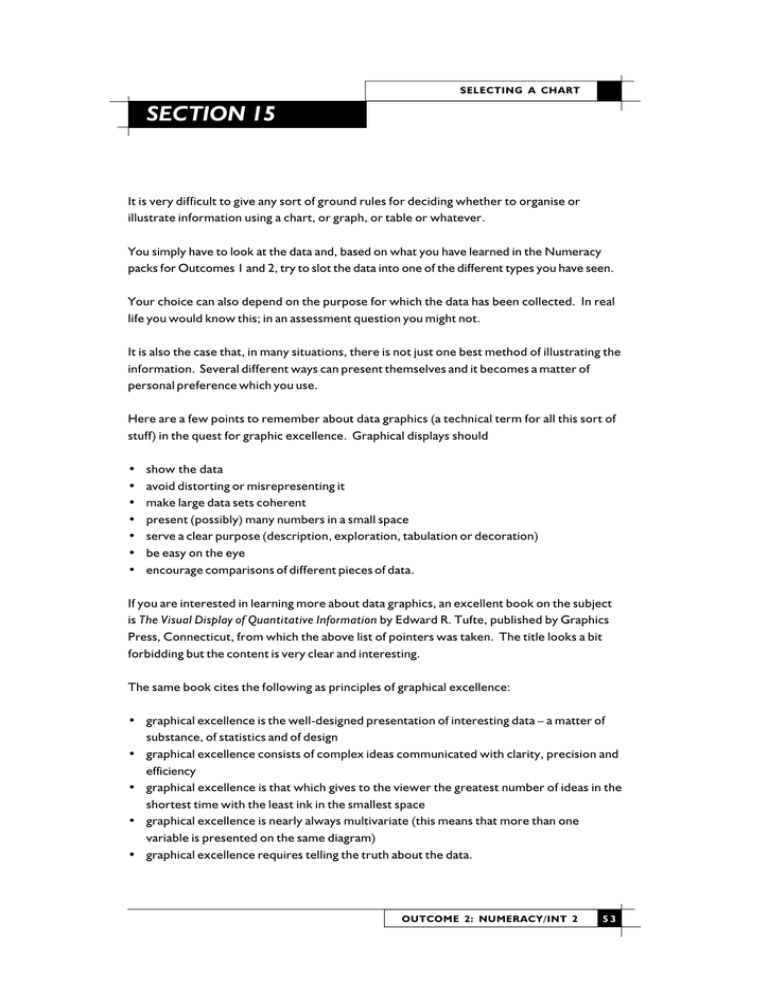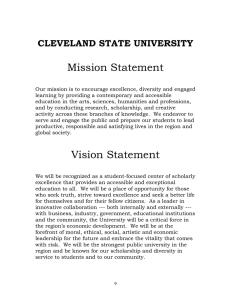SECTION 15
advertisement

SELECTING A CHART SECTION 15 It is very difficult to give any sort of ground rules for deciding whether to organise or illustrate information using a chart, or graph, or table or whatever. You simply have to look at the data and, based on what you have learned in the Numeracy packs for Outcomes 1 and 2, try to slot the data into one of the different types you have seen. Your choice can also depend on the purpose for which the data has been collected. In real life you would know this; in an assessment question you might not. It is also the case that, in many situations, there is not just one best method of illustrating the information. Several different ways can present themselves and it becomes a matter of personal preference which you use. Here are a few points to remember about data graphics (a technical term for all this sort of stuff) in the quest for graphic excellence. Graphical displays should • • • • • • • show the data avoid distorting or misrepresenting it make large data sets coherent present (possibly) many numbers in a small space serve a clear purpose (description, exploration, tabulation or decoration) be easy on the eye encourage comparisons of different pieces of data. If you are interested in learning more about data graphics, an excellent book on the subject is The Visual Display of Quantitative Information by Edward R. Tufte, published by Graphics Press, Connecticut, from which the above list of pointers was taken. The title looks a bit forbidding but the content is very clear and interesting. The same book cites the following as principles of graphical excellence: • graphical excellence is the well-designed presentation of interesting data – a matter of substance, of statistics and of design • graphical excellence consists of complex ideas communicated with clarity, precision and efficiency • graphical excellence is that which gives to the viewer the greatest number of ideas in the shortest time with the least ink in the smallest space • graphical excellence is nearly always multivariate (this means that more than one variable is presented on the same diagram) • graphical excellence requires telling the truth about the data. OUTCOME 2: NUMERACY/INT 2 53 SELECTING A CHART On a more mundane level, here are a few suggestions about which form of presentation to use: • pie chart or component bar chart if relative proportions of a whole are required (percentage version might be useful) • simple bar chart for graphing a very straightforward list of options with associated frequencies • compound bar chart for comparing two (or three at the most) different sets of frequencies • line graph if plotting data over a period of time • scatter diagram if looking for relationships between two variables • histogram if looking at grouped frequencies, especially if the widths of the groups are not all the same size • ogive if trying to find frequencies above, below or in between values which lie within the intervals (intervals as in a histogram) • frequency table or stem–leaf chart if trying to organise a large set of numbers for the purposes of further analysis, either pictorially or by calculation • table if trying to make sense of a lot of data which can actually be divided up into various categories, probably not numerical ones. The above hints form only a rough guide and cannot be considered exhaustive (though you may well feel exhausted after trailing through them all). With all the practice you have had, the correct method of presentation will, we hope, be fairly obvious. This concludes the work required for Outcome 2. I hope you found it interesting (and my tongue is miles away from my cheek when I say that!). You should now try the Tutor Assignment that follows and send your answers to your tutor. 54 OUTCOME 2: NUMERACY/INT 2

